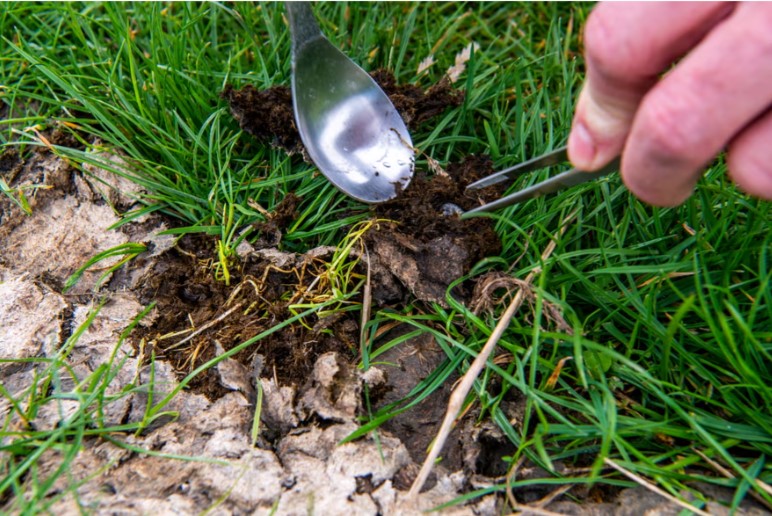Why we should all dig into poo – all you need is a spoon

Cowpats in a Cambridge meadow offer vital lessons in how a host of tiny creatures sustain our planet
Summer is ending, and Coe Fen meadow in Cambridge is entering a period of slumber. The cows are sheltering under a tree, whisking away flies and defecating as they lie down. Spring’s succulent grasses have been supplanted by scruffier dock leaves, thistles and nettles. Berries on the trees and the reddening of leaves show that autumn is waiting backstage.
We are exploring the delights of faeces and the little ecosystems inside them. Cowpats are the obvious choice because of their abundance, and they are also the least offensive on offer.
Prof Ed Turner, curator of insects at Cambridge University, digs into one with a teaspoon. Rather like an episode of The Great British Bake Off, he is talking us through textures and ingredients.
This one is a good bake. The mound of undigested food has probably been there for a couple of weeks, a mixture of faeces and urine lightly roasted by the summer sun. The outside is crispy but it’s still moist inside. Wiry white-yellow grasses that look like they have been electrocuted are growing out of the top.
Cow dung contains 24 minerals – including nitrogen, potassium, sulphur, iron, magnesium, copper, cobalt and manganese – as well as a rich diversity of bacteria and fungi. “There is a whole suite of animals that feed on this,” says Turner.
This is a nursery for new life. We quickly find a juicy, translucent dung beetle larva, gorging itself on poo, in what looks like a semi-conscious stupor. “It’s pretty, isn’t it? It’s folded over – that’s a classic shape,” says Turner.

There are up to 20 more larvae, and others will have burrowed underground. Each has its own little sleeping cabin, connected with tunnels. They live in complete darkness, and squirm when exposed to the sun. The UK is home to more than 60 species of dung beetle.
We also find rove beetles, mites, springtails, ants, spiders and earthworms. Birds and mammals also come to feast on the cowpats. Turner describes it as “hooching with life”.
He says: “Thirty or 40 people have walked past this morning and have no idea these animals are here.” I tell a passing walker that we are studying cow dung and she says her dog would like to help us, though she wouldn’t.
The creatures living on the cowpats are providing us with a great service. These decomposers play a critical role in breaking down organic matter, taking it into the soil and making it available for plants and other creatures.
Without nature’s recyclers, our planet would be awash with dung. Research suggests that dung beetles may save the UK cattle industry more than £40m a year through their ability to remove faeces, increase soil nutrients and reduce the number of flies.
All around us, mammals’ faeces is providing food for a range of animals. These cows are unmedicated (meaning the dung is chemical-free), making it particularly attractive to invertebrates. Because of this, it is processed and removed faster than that of medicated animals. Turner says: “When you’ve got more species, you get an enhanced ecosystem function, which basically in this case is dung removal.
“The more species you’ve got, the faster that function is – this is a tiny example of that,” he says.
Faeces have a long legacy. Along the path are tufts of longer grasses, which are the ghosts of previous cow dung. This succession is already happening in the dung we have excavated – around the edge is a ring of longer, darker grass that has benefited from the nutrients being absorbed into the soil. Turner calls this the halo effect.
It is an indication of the nourishment faeces can give soil when left in moderation. Carcasses and deadwood – also full of dead and decaying matter – do a similar thing, forming the basis of rich habitats. Yet many consider deadwood, animal carcasses and faeces to be unsightly, or just waste.
There can be more than 280 invertebrates in one large handful of rotten wood inside a tree, yet it is often cleared away to make things more “tidy”. In a natural woodland, a quarter of wood is dead, but in most woodland managed by humans, it is less than 10%, according to the Wildlife Trusts.
In the same way, cow dung is seen as unsightly. In 2021, Turner was part of the Cowpats About Cambridge campaign, inviting people to send in photos of beetles found in dung. How many people sent in pictures? “Not that many, actually,” he admits.
I ask how many times he has come out here and found people inspecting poo. “It hasn’t happened yet.”
Turner wants us to get out and look at everyday wildlife, even if they are wood pigeons and magpies (which seem to be doing well in this meadow). This includes digging into cowpats or turning over old logs. If people are not curious about these ordinary things, conservation is dead, he says.
“Ultimately, [common] things like that can help protect rare things as well, because when people get engaged in wildlife, it’s addictive,” he says.
The starter kit is simple. “All you need is a spoon,” says Turner. “Make sure you wash it afterwards.”
Photograph: Jill Mead/The Guardian - A dung beetle larva in a cowpat. ‘There is a whole suite of animals that feed on this,’ says Prof Ed Turner.









